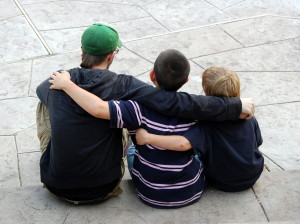 The word orphanage often conjures up images of raggedy Oliver Twist and Annie in destitute surroundings with scores of poor children, but the institution holds a vital place in the history of caring for foster children dating back to the late 19th century.
The word orphanage often conjures up images of raggedy Oliver Twist and Annie in destitute surroundings with scores of poor children, but the institution holds a vital place in the history of caring for foster children dating back to the late 19th century.
During a time when few options existed, orphanages housed and cared for children who were abandoned or whose parents were temporarily unable to care for them.
Most orphanages began with religious roots as a way to fulfill the teachings of Christ. After the Civil War, states began building orphanages for war orphans. The need for larger institutions to take on parent-less children continued to grow with the Industrial Revolution.
“As industry expanded rapidly and immigration increased, more children lost one or both parents to accidents, illness and despair,” according to the Encyclopedia of Children and Childhood in History and Society. “Jewish orphanages and fraternal orphanages were established, as well as county orphanages financed by local governments.”
The rise of orphanages
By the end of the 19th century, orphanages were considered one of the best methods for caring for dependent children, with many poor single parents regarding them as places to leave their children until circumstances improved.
Early orphanages such as the Bethesda Orphanage, founded in 1740 in Savannah, Georgia and the Hephzibah Orphanage, founded in 1900 in Macon, Georgia were often largely funded by private and church donations, according to a paper titled “A Return to Orphanages?” by Children’s Rights Organization.
Both institutions exist today, albeit with different names. The Bethesda Home for Boys is a treatment and family oriented center who serves boys from 6 to 14 years if age while the Hephzibah Children’s Association “offers residential, long-term care for ‘young children who have been traumatized by abuse, neglect or loss of their parents,’ although it also offers family based services, foster care services, and school-age day care,” according to “A Return to Orphanages?”
In both cases, the word orphanage doesn’t appear anywhere in their names or description.
The attack on orphanages
That’s because orphanages, as they were known, fell out of favor in America in the early 1900s. Growing concerns about the emotional and cognitive development of children institutionalized in orphanages prompted studies that showed all children, but especially babies, often did not receive enough “eye contact, physical contact and stimulation to promote proper physical, social or cognitive development,” according to a Unicef report titled “Caring for Orphaned, Abandoned and Maltreated Children.”
After institutional care for children fell into disfavor, the shift was for children to receive more direct support and services for families with adoption becoming the goal. Orphanages began closing in the 1920s, with many charities creating instead foster care agencies.
“The Depression years depleted the institutions’ resources and forced them to place out children in foster families,” according to the Encyclopedia of Children and Childhood in History and Society. “The 1935 Aid for Dependent Children legislation made it possible for more families to care for children whom they might otherwise have had to place in orphanages.”
By the 1950s, states had taken over responsibility for care of dependent children and the anti-institutionalization movement of the 1960s closed most remaining orphanages.
The return of a new kind of orphanage
But that wasn’t the end. In 1994, Congressman Newt Gingrich suggested a return to orphanages, citing that the system was faced with a shortage of foster parents and an ever-increasing number of children were entering the foster care system. While opponents continued to argue against it, citing the emotional and developmental issues of institutionalization, supporters emphasized the importance of permanency for troubled children.
The drumbeat of support continued into the 2000s where more and more “children’s homes,” “residential treatment homes” and “group care facilities” have opened up across the country. These facilities may not use the charged word of orphanages in their names or description, but they bear resemblance, according to “A Return to Orphanages?”
“Nonetheless, many facilities operate as ‘de facto’ orphanages, articulating values related to children’s connections with family but not actually engaging in affirmative efforts to reunite children with their parents or extended families or finding new families for them through adoption. In these cases, children remain in the facilities’ permanent care until they age out of the foster care system. These facilities essentially serve as substitute “families” for children and youth even though they shun the label of “orphanage.”
These types of facilities continue to operate in New Jersey and throughout the country with supporters championing the educational benefits, permanency and stability these institutions offer to children. Critics, such as Children’s Rights, argue that efforts should be focused on improving the foster care system instead of “institutionalizing” foster children.
What do you think?

My mother was placed with a Foster Family in about 1916 in Passaic County NJ. Is it possible to get a copy of her file? We do not know her mother’s name, only her father’s name and the name of the family that she was placed with. We also do not know what happened to her parents.
Thank you for any help you can give to me.
Sincerely,
Elaine Struening
Is there any way/place that I can find a comprehensive list of N.J. orphanages ca. 1915-25? I am particularly looking for institutions in the Paterson-Passaic area. I would be grateful for any help that I can get from you! Thanks!
Thanks for this brief history. My grandmother was placed in an orphanage and it was a very defining time in her life.